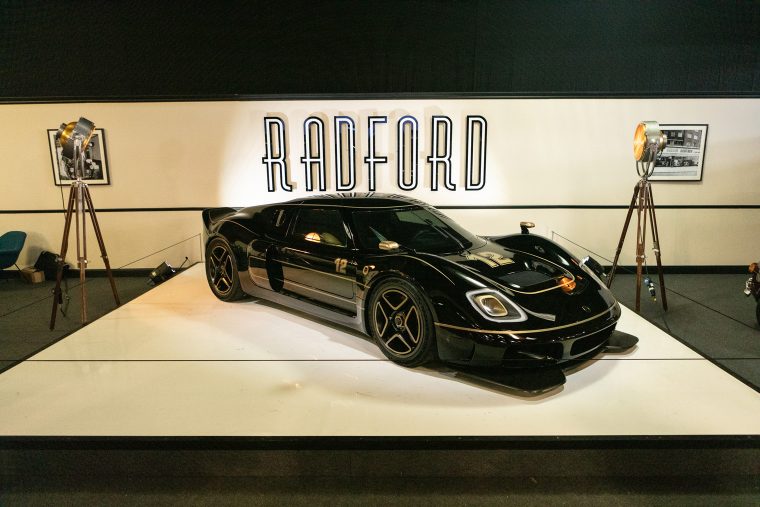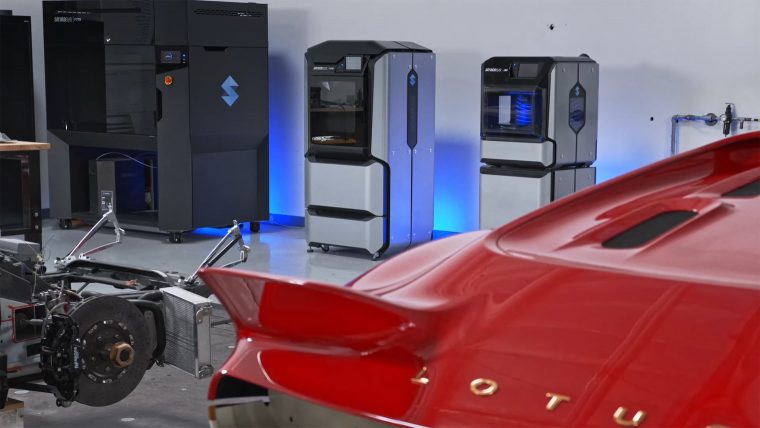3D printer manufacturer Stratasys has designed and 3D printed more than 500 parts for a relaunch of the classic Lotus’ Type 62-2 sports car coachbuilt as part of a new Discovery+ documentary, Radford Returns.
Historic coachbuilding firm Radford is leveraging 3D printing throughout the documentary, which stars car builder Ant Anstead and former Formula 1 champion racecar driver Jenson Button. The documentary follows the pair as they build a revival of the retro-modern Lotus Type 62-2 supercar, with viewers given an inside look at the process of designing, prototyping, and producing the parts leveraging Stratasys’ FDM, PolyJet and SLA 3D printing technologies.
“Stratasys’ 3D printing technology gave us the design freedom and ability to easily create customized, one-off pieces and parts for these two prototype vehicles,” said Anstead. “It gave us the ability to fully embrace customized coachbuilding but with updated processes using 21st century technologies.”
Stratasys’ starring roles
This isn’t the first time Stratasys’ 3D printing technologies have appeared on our television screens, with the firm having had other previous stints in helping to restore classic cars for the cameras.
Back in 2019, Stratasys teamed up with comedian Jay Leno’s Big Dog Productions to support his motor vehicle television series “Jay Leno’s Garage”, in which he conducts reviews on a wide range of vehicles, including vintage and restored cars. Stratasys provided Leno with access to its FDM 3D printers to service the collection of vehicles that appeared on the show with 3D printed custom parts.
Meanwhile last year, Stratasys’ Fortus 400mc 3D printer was used to 3D print a customized central console of a 1970s Ford Cortina Mark III X for popular British automotive TV show Car SOS, aired on National Geographic. The console was replicated by 3D scanner manufacturer Artec’s UK ambassador Central Scanning before being printed on the Fortus 400mc in just eight hours to meet the show’s tight timeframe.
Stratasys and Radford first announced their intention to build 62 reimaginings of Lotus’ Type 62-2 sports car in August last year, and now viewers can see the process behind the build with the release of the documentary.

500 3D printed parts
For its latest television appearance, Stratasys 3D printed more than 500 parts for two Lotus Type 62-2 sports cars. The Radford team utilized the firm’s GrabCAD Shop workflow software to schedule and track their 3D prints across five global locations, using a fleet of up to 20 of the firm’s various 3D printers at one time.
The team made use of Stratasys’ F900, F770, Fortus 450mc, F370 and J55 3D printers to produce different desired outcomes for each part, which ranged from a large solid composite firewall sandwich core to smaller exterior items like side mirror housings and mounting brackets.
“By integrating 3D printing technology into their shop, Radford has been able to bring 1960s-style supercar automaking into the 21st century with the high-end, hyper-customized style and features that their customers expect in a vehicle of this caliber,” said Pat Carey, Senior Vice President, Strategic Growth, at Stratasys. “It’s an extreme example of something we see every day in the auto industry.
“Everyone making investments in new vehicles wants a deeper level of customization and 3D printing is helping make it possible.”

The composite firewall sandwich core was 3D printed in two halves on Stratasys’ F900 machine in ULTEM 1010 resin before being bonded together in a single piece and wrapped with carbon fiber. The part’s design included complex mourning features for interior speakers, a fuel filler mount, and a luggage compartment.
The exterior parts, including the side mirror housings, radiator ducts, and body vents, were 3D printed in FDM Nylon 12 Carbon Fiber and ASA materials, while numerous mounting brackets were fabricated from FDM Nylon 12 CF. Additive manufacturing was particularly suited to the production of these parts due to the strength requirements of the applications and the complete design freedom offered by the technology.
“When relaunching Radford, we set out to only work with world-class companies,” said Anstead. “Lotus is a world-class company, Radford is a world-class company, so when we looked to 3D printed parts, we looked to Stratasys.”
Going forwards, Stratasys will continue to support the Radford Lotus Type 62-2 project with 3D printed production parts, and in addition to its FDM, PolyJet and SLA technologies will also utilize its P3 Programmable PhotoPolymerization and SAF 3D printing processes.

Subscribe to the 3D Printing Industry newsletter for the latest news in additive manufacturing. You can also stay connected by following us on Twitter and liking us on Facebook.
Looking for a career in additive manufacturing? Visit 3D Printing Jobs for a selection of roles in the industry.
Subscribe to our YouTube channel for the latest 3D printing video shorts, reviews and webinar replays.
Featured image shows Ant Anstead shows a 3D printed part for the Lotus Type 62-2 coachbuilt as shown in the Discovery+ documentary, Radford Returns. Photo via Stratasys.



